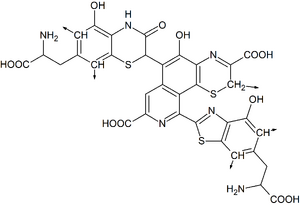Melanin
As melanin we refer to some polymeric pigments derived from tyrosine and its derivatives. They stain the skin, parts of the eye and other tissues. In nature, there are also types of melanin that are not found in mammals and humans (e.g. in mushrooms, bird feathers, some bacteria produce them, etc.). The common characteristic remains the polymeric polyphenolic structure and the dark color, according to which this diverse group of substances is named (μέλας = black, dark).
In human cells, melanin is most often stored in specialized organelles derived from the Golgi complex, melanosomes. More rarely, it is stored in lysosomes – in nervous tissue in subst. nigra and in the locus coeruleus.
Classification of melanins[edit | edit source]
The exact chemical structure of melanins is still largely unknown. Nevertheless, four groups of melanins are usually distinguished in humans[1]:
- eumelanin,
- pheomelanin,
- mixed melanin,
- neuromelanin.
Eumelanin predominates in humans. It is mostly brown-black in color. It consists of dihydroxyindole and dihydroxyindolecarboxylic acid. Both of these substances can be in oxidized or reduced form. In some units, the indole ring is additionally cleaved, so that units with a pyrrole ring are formed[1]. Dihydroxyindole derivatives arise from the amino acid tyrosine, or of its hydroxy derivative [[Dopamine|Template:L-DOPA]], which is cyclized to form an indole nucleus.
Pheomelanin has a yellow-orange or red color. It consists mainly of benzothiazine and benzothiazole units. These are also formed from Template:L-DOPA, but the amino acid cysteine also enters the synthesis as a source of heterocyclic sulfur. The structure of pheomelanin is more complex, the polymer molecule is often branched.
Mixed melanins contain a mixture of eumelanin and pheomelanin structures.
Unlike the previous ones, Neuromelanin is produced in lysosomes. Some areas of the central nervous system contain it.
Links[edit | edit source]
Related Articles[edit | edit source]
References[edit | edit source]
- ↑ a b CARLETTI, Giorgio – NERVO, Giuseppe – CATTIVELLI, Luigi. Flavonoids and Melanins: a common strategy across two kingdoms. Int J Biol Sci [online]. 2014, vol. 10, no. 10, p. 1159-70, Available from <https://doi.org/10.7150/ijbs.9672>. ISSN 1449-2288.


